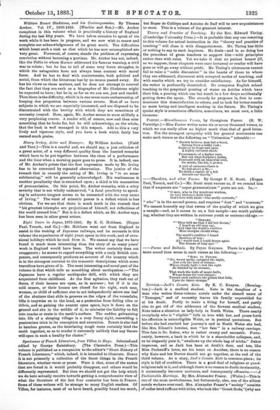NOVELS.—Jack's Cousin Kate. By E. C. Kenyon. (Reming- ton.)—Jack is
a medical student. Kato is the daughter of a man who writes three-volume novels under the absurd name of " Tamogen," and of necessity leaves his family unprovided for at his death. Partly to make a living for herself, and partly also to get rid of the addresses of the fervent medical student, Kate takes a situation as lady-help in North Wales. There nearly everybody who is " eligible " falls in love with her, and pours forth his affection in unintelligible Welsh, or in poetical quotations. But before she had reached her journey's end in North Wales she had, like Mrs. Eiloart's heroine, met "her fate" in a railway carriage. This fate is Dr. Daker, who is rather crusty and sarcastic. Fortu- nately, however, a bank in which he is a shareholder collapses, and, as he elegantly puts it, "swallows up the whole bag of tricks." Daker improves, and as Jack has been at death's door, and has, like Miss Pecksniff's lover, set his heart on Another, there is no reason why Kate and her Doctor should not go together, at the end of the third volume. As a story, Jack's Cousin Kate is common-place; its style is full of craditiea. There is a good deal of religious or quasi. religious talk in it, and although there is no reason to doubt its sincerity, it occasionally becomes unctuous, and consequently offensive.—A Fashionable Marriage. By Mrs. Alexander Fraser. (White.)—This is one of the most unwholesome, but fortunately, also, one of the silliest novels we have ever read. Mrs. Alexander Fraser's "society "consists of under-bred ruffians with titles, who look like "Greek Gods,"(why are the "Greek Gods" always insulted in fiction of this kind ?) drink "tumblers of brandy," or "call lustily for a whisky-and-soda," when
they have any special villainy on hand ; and vulgar, heartless, mer- cenary " sirens " or " Fanstines," with "white, alabaster arms," and "great, almond-shaped, milk-white-lidded eyes." Mrs. Fraser, in- deed, pats a little comedy into her portrait of Bella Grant, who is the chief female villain of her story, and proceeds from poisoning to lunacy, for we find that she reads the Parliamentary debates, and "as Bmdlaugh has her entire sympathy, her face is unbecomingly flashed, and her gray eyes gleam with hot partisanship in a hideous cause." Bat Mrs. Fraser surely carries her courage (shall we term it ?) too far, when she introduces into her story living and well-known ladies under the thinnest of dis- guises, and when she gives names to the parties in the divorce case, which is the last scene but one of her strange history, that at once recall personages that actually figured in a recent cause ceabre. —Dame Durden. By "Rita." (Tinsley Brothers.)—It is enough to say of this novel that it is superior to most of the author's work. There is a good deal of what we can only style strenuosity in it, but it is not unwholesome. The tragic loves of Paul and Lady Maud are told with some power, and although we get rather tired of their foils, Eric and Marjorie, there are very much worse characters in some of " Rita's " other fictions.



































 Previous page
Previous page